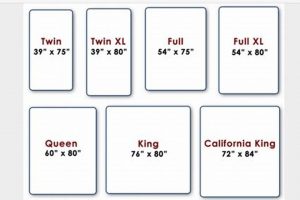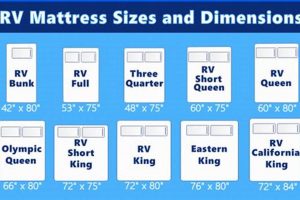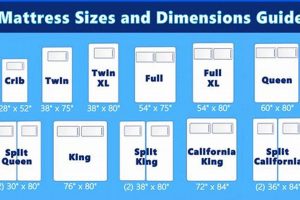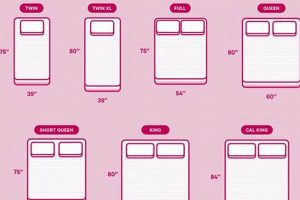A shortened queen mattress designed for recreational vehicles typically measures 60 inches wide by 75 inches long. This is in contrast to a standard queen mattress, which is 80 inches in length. The reduced length is a key characteristic, allowing it to fit within the often space-constrained sleeping areas of RVs, campers, and trailers.
The adoption of this mattress size addresses the practical needs of RV owners seeking a balance between sleeping comfort and maximizing usable space inside their vehicles. It permits the inclusion of a larger sleeping surface compared to twin or full-sized options, while still accommodating other essential RV features and storage areas. Historically, specialized RV mattresses developed as a direct response to the unique dimensional challenges presented by mobile living spaces.
Understanding the dimensions is vital for selecting appropriate bedding and ensuring compatibility with RV bed frames. Careful measurement of the available space and consideration of mattress thickness are essential steps in the purchasing process. This article delves further into specific aspects related to selecting and maintaining a properly sized RV mattress.
Tips on Selecting an Appropriately Sized RV Mattress
Selecting the correct mattress dimensions for a recreational vehicle is crucial for comfort and efficient space utilization. The following tips provide guidance on ensuring a proper fit and maximizing the benefits of the sleeping area.
Tip 1: Measure the Bed Frame Accurately: Prior to purchasing, meticulously measure the interior dimensions of the RV bed frame. Account for any obstructions or protrusions that may affect the available space.
Tip 2: Consider Mattress Thickness: Evaluate the desired mattress thickness in relation to headroom and overall sleeping height. A thicker mattress can enhance comfort but may reduce available headroom.
Tip 3: Verify Mattress Specifications: Always confirm the stated dimensions with the manufacturer or retailer. Slight variations can occur, so precise measurements are essential.
Tip 4: Account for Bedding: Allow extra space for bedding such as sheets, blankets, and comforters. These items can add to the overall bulk and affect the fit within the RV’s sleeping area.
Tip 5: Assess Doorway and Aisle Clearance: Ensure that the chosen mattress size allows for adequate clearance within the RV’s doorways and aisles. Avoid selecting a mattress that obstructs movement or access to other areas.
Tip 6: Prioritize Comfort and Support: While size is important, do not compromise on comfort and support. Research different mattress types and materials to find one that meets individual sleeping preferences.
Tip 7: Check Return Policies: Confirm the retailer’s return policy before making a purchase. This is important in case the selected mattress does not fit properly or meet expectations after delivery.
Adhering to these guidelines ensures that the selected mattress optimally utilizes the available space while providing a comfortable and supportive sleeping surface within the recreational vehicle.
The subsequent sections will address factors concerning mattress materials and maintenance to maximize longevity.
1. Width
The “Width: 60 inches” specification is a foundational element in defining the dimensions of an RV short queen mattress. It dictates the lateral space occupied by the mattress, directly influencing the comfort and maneuverability within the recreational vehicle.
- Space Optimization
A 60-inch width is a deliberate design choice that balances sleeping area with the constrained space common in RVs. A wider mattress would encroach upon living areas, while a narrower one might compromise sleeping comfort. This width allows for comfortable accommodation of two adults, optimizing interior space.
- Standard Bed Frame Compatibility
RV short queen bed frames are specifically designed to accommodate a mattress with a 60-inch width. Deviating from this dimension would render the mattress incompatible, potentially leading to instability or damage to the frame. Adherence to this standard ensures seamless integration.
- Bedding Considerations
The 60-inch width directly affects the selection of appropriate bedding. Standard queen-sized bedding, while having the appropriate width, often features excess material due to the greater length. Bedding designed specifically for RV short queen mattresses, or modified standard bedding, is necessary to ensure a snug and neat fit.
- Impact on Sleep Quality
The designated width plays a critical role in comfort, affecting how freely a person can move during their sleep. Its a balance between the limited space inside an RV and the need for a spacious sleeping area. Understanding these dimensions is essential for creating a good experience inside the RV.
The 60-inch width is a definitive characteristic of the RV short queen mattress, governing space utilization, bed frame compatibility, bedding selection, and ultimately, sleeping comfort. Its adherence to this specification is critical for ensuring functionality and enhancing the overall RV experience.
2. Length
The “Length: 75 inches” specification is a defining factor distinguishing a recreational vehicle (RV) short queen mattress from standard queen-sized mattresses, significantly impacting spatial efficiency within the confined interiors of RVs and campers.
- Spatial Optimization in RVs
The 75-inch length is deliberately shorter than the standard 80-inch queen mattress to accommodate the limited floor space characteristic of RV bedrooms. This reduction allows for easier maneuverability around the bed and enables the incorporation of other essential RV features, such as storage cabinets or walkways, without compromising sleeping surface area excessively. The altered dimension is crucial in RV design, balancing comfort with practical spatial constraints.
- Compatibility with RV Bed Frames
RV short queen bed frames are manufactured to specifically fit mattresses measuring 75 inches in length. Using a standard queen mattress, which exceeds this dimension, would result in an improper fit, potentially damaging the bed frame or compromising the mattress’s structural integrity. The adherence to this length ensures seamless integration and stability within the RV sleeping environment.
- Bedding and Accessory Considerations
The 75-inch length influences the selection of appropriate bedding and accessories. Standard queen-sized sheets, designed for an 80-inch mattress, will exhibit excess material when used on an RV short queen. Specialized RV short queen bedding, or carefully fitted standard bedding, is necessary to prevent bunching and ensure a comfortable sleep surface. This altered length must be taken into account when selecting linens and mattress protectors.
- Impact on Sleep Quality and Ergonomics
The 75-inch length directly affects the overall sleeping experience, particularly for taller individuals. While shorter than a standard queen, it still offers adequate space for many users. However, those exceeding a certain height may experience a compromise in comfort. The implications on spinal alignment and overall ergonomic support should be considered when selecting this mattress size to mitigate potential discomfort.
The 75-inch length is a fundamental dimension of RV short queen mattresses, shaping spatial dynamics, bed frame compatibility, bedding options, and ergonomic considerations within the context of mobile living. Understanding its implications is essential for RV owners seeking to maximize comfort and functionality within their limited space.
3. Thickness (Variable)
The thickness of a recreational vehicle (RV) short queen mattress, unlike its width and length, is not a fixed dimension. This variability introduces a crucial element of customization and directly affects comfort, support, and overall space utilization within the RV. The importance of understanding this lies in its direct impact on the sleeping experience and the practical constraints of RV living.
Thickness is determined by the materials used in the mattress’s construction, such as foam density, the presence of innerspring coils, and the inclusion of comfort layers like memory foam or gel infusions. A thicker mattress generally provides enhanced cushioning and support, accommodating a broader range of body weights and sleeping preferences. However, increased thickness also reduces headroom within the RV’s sleeping area and can affect the ease of getting in and out of bed. Conversely, a thinner mattress, while conserving space, may compromise support and long-term comfort, particularly for individuals requiring specific orthopedic support. For example, an RV owner with back pain might prioritize a thicker memory foam mattress for pressure relief, despite its potential impact on headroom, while another owner with limited overhead space might opt for a thinner, albeit less plush, option. The choice is a direct trade-off between comfort and spatial efficiency.
In summary, the variable thickness of an RV short queen mattress necessitates careful consideration. The optimal thickness depends on individual comfort needs, physical requirements, and the specific spatial constraints of the RV’s bedroom. Neglecting this dimension can lead to discomfort, limited mobility, or an inefficient use of available space. Properly balancing thickness with other size parameters ensures that the mattress serves its intended purpose: providing restful sleep within the compact confines of a recreational vehicle.
4. Frame Compatibility
Frame compatibility is an intrinsic element of the RV short queen mattress concept, serving as a fundamental constraint within the design parameters. The standardized dimensions60 inches wide by 75 inches longdictate the types of bed frames appropriate for use. An incompatibility between the mattress dimensions and the frame dimensions can result in inadequate support, premature mattress wear, or even structural damage to the frame itself. For example, attempting to place a standard queen mattress, which is 80 inches long, onto a frame designed for a 75-inch mattress results in overhang, compression, and uneven weight distribution.
RV manufacturers specifically design bed frames to accommodate the unique size constraints imposed by the short queen mattress. These frames typically include support slats or a solid platform engineered to provide consistent support across the entire mattress surface. Using a frame intended for a different mattress size not only compromises support but also voids warranties on both the mattress and the frame in many instances. Furthermore, proper frame compatibility ensures that the mattress remains securely in place during vehicle movement, preventing shifting or sliding that could pose safety hazards.
The crucial connection between frame and mattress size underscores the importance of verifying dimensions prior to purchase. An accurately sized frame ensures optimal support, prolongs the lifespan of the mattress, and contributes to overall safety and comfort within the recreational vehicle. Therefore, frame compatibility represents a non-negotiable aspect of the RV short queen mattress system.
5. Interior Space
The dimensions of an RV short queen mattress, specifically its reduced length compared to a standard queen, directly correlate with the optimization of interior space within a recreational vehicle. Limited floor area necessitates careful consideration of each component’s footprint, and the choice of a shortened mattress significantly impacts the overall usability of the living area. The implementation of this particular mattress size mitigates encroachment on walkways, storage compartments, and other essential amenities, thereby contributing to a more functional layout.
For instance, in smaller travel trailers, a standard queen mattress might impede access to wardrobes or create a cramped sleeping quarter, diminishing the overall experience. Conversely, the adoption of an RV short queen mattress alleviates this issue by providing adequate sleeping space while preserving essential interior mobility. Manufacturers often tailor RV designs around this mattress size to maximize the perceived roominess and practical utility of the vehicle. The integration of features like bedside tables or overhead storage becomes more feasible when the bed occupies a smaller physical area.
Ultimately, the selection of an RV short queen mattress is predicated on a strategic compromise between sleeping comfort and spatial efficiency. This decision acknowledges the inherent constraints of RV interiors and prioritizes a balanced approach to design. While a larger mattress might offer enhanced sleeping surface, its impact on overall maneuverability and accessibility within the vehicle would be detrimental. Thus, the short queen size serves as a critical factor in optimizing interior space and promoting a more comfortable and functional RV experience.
6. Bedding Fit
Bedding fit is a critical consideration directly influenced by the dimensions of a recreational vehicle (RV) short queen mattress. Standard bedding sizes are often incompatible, necessitating specialized solutions to ensure both comfort and aesthetic appeal within the limited confines of an RV.
- Sheet Dimensions
Standard queen-sized sheets, designed for mattresses 80 inches in length, will exhibit excess fabric when used on a 75-inch RV short queen mattress. This surplus material can bunch up, creating discomfort and affecting the overall sleeping experience. Fitted sheets specifically tailored to the 60″ x 75″ dimensions are necessary to achieve a snug, wrinkle-free fit. For example, purchasing RV short queen sheet sets eliminates the need for alterations or compromises in comfort.
- Comforter and Blanket Sizing
Similarly, comforters and blankets designed for standard queen mattresses will typically extend beyond the foot of an RV short queen bed. This excess length can be visually unappealing and impractical in the limited space. Shortened comforters or blankets, or the folding and tucking of standard sizes, represent common adaptations. Some manufacturers offer RV-specific bedding sets that include comforters with appropriately reduced dimensions, ensuring a balanced aesthetic.
- Mattress Protector Considerations
Mattress protectors, essential for hygiene and mattress longevity, must also conform to the specific dimensions of the RV short queen. An ill-fitting protector can shift and bunch, negating its protective benefits and causing discomfort. Sizing accuracy is paramount when selecting a mattress protector for this mattress type.
- Pillow Placement and Size
While pillow size is less directly impacted, the overall bedding ensemble influences pillow placement. A neatly fitted sheet and appropriately sized comforter create a more streamlined and organized appearance, enhancing the visual appeal of the sleeping area. Proper bedding fit contributes to the perception of spaciousness within the confined RV interior.
The relationship between bedding fit and the dimensions of an RV short queen mattress underscores the need for careful selection and adaptation. Opting for specialized RV bedding or making alterations to standard sizes ensures a comfortable, functional, and aesthetically pleasing sleeping environment, maximizing the utility of space within the recreational vehicle.
Frequently Asked Questions
This section addresses common inquiries regarding the dimensions and applications of RV short queen mattresses. Accurate information is crucial for making informed purchasing decisions and ensuring optimal comfort and functionality within recreational vehicles.
Question 1: What are the precise measurements of a standard RV short queen mattress?
The standard dimensions of an RV short queen mattress are 60 inches in width and 75 inches in length. Thickness can vary based on construction materials.
Question 2: How does an RV short queen mattress differ from a standard queen mattress?
The primary difference lies in length. A standard queen mattress measures 80 inches long, while the RV short queen is 75 inches long, making it more suitable for the limited space in recreational vehicles.
Question 3: Can standard queen-sized sheets be used on an RV short queen mattress?
Standard queen sheets will fit the width, but the excess length will result in bunching and an improper fit. Specialized RV short queen sheets are recommended.
Question 4: Are all RV bed frames designed to accommodate an RV short queen mattress?
Most RV bed frames are designed for this mattress size, but it is imperative to verify dimensions before purchasing a mattress. Deviation can lead to instability and damage.
Question 5: Does the reduced length of an RV short queen mattress compromise sleeping comfort?
For most individuals, the 75-inch length provides adequate sleeping space. However, taller individuals may find it less comfortable. Consider individual height and sleeping preferences.
Question 6: Where can RV short queen mattresses be purchased?
These mattresses are available through specialty RV supply stores, online retailers, and some traditional mattress stores. Verify dimensions and return policies prior to purchase.
Accurate dimensions are paramount when selecting a mattress for an RV. Understanding these specifics ensures a comfortable and functional sleeping environment.
The subsequent section will delve into the materials commonly used in RV short queen mattresses and their impact on comfort and durability.
Conclusion
This exploration has provided a comprehensive overview of what size is a rv short queen mattress, emphasizing its critical dimensions of 60 inches in width and 75 inches in length. These specific measurements dictate its compatibility with RV bed frames, impact interior space utilization, and necessitate specialized bedding solutions. A clear understanding of these factors is paramount for RV owners seeking to optimize comfort and functionality within their mobile living spaces.
The selection of an appropriately sized mattress represents a significant investment in both comfort and the overall RV experience. Consider the outlined parameters carefully to ensure a harmonious balance between sleeping comfort and efficient space management, contributing to safer and more enjoyable travels.




![Best Queen Size Mattress with Boxspring [Deals!] Organic & Natural Mattress Buyer’s Guide: Non-Toxic Sleep Solutions Best Queen Size Mattress with Boxspring [Deals!] | Organic & Natural Mattress Buyer’s Guide: Non-Toxic Sleep Solutions](https://mattressworldpa.com/wp-content/uploads/2025/07/th-2253-300x200.jpg)
![Futon vs Reg Mattress Size: Are They The Same? [Guide] Organic & Natural Mattress Buyer’s Guide: Non-Toxic Sleep Solutions Futon vs Reg Mattress Size: Are They The Same? [Guide] | Organic & Natural Mattress Buyer’s Guide: Non-Toxic Sleep Solutions](https://mattressworldpa.com/wp-content/uploads/2025/07/th-2252-300x200.jpg)

